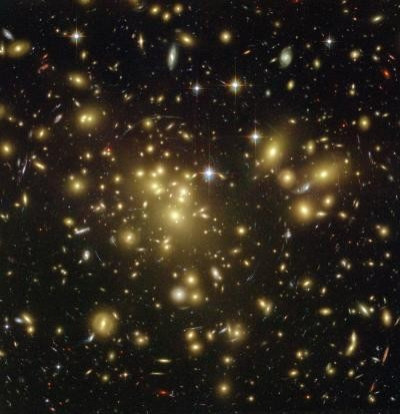Galaxies say Einstein's Theory of Relativity is Cosmologically True

A new research on galaxy clusters emerged to validate Albert Einstein's general theory of relativity, on a cosmological scale. Its findings also support the presence of invisible dark matter.
The general theory of relativity, published by the German physicist in 1916, states that the gravity of an object is a geometric property of space and time. While the theory was previously proven only within the solar system, a group of astrophysicists have newly proved Einstein's theory of gravity on scales larger than the solar system, something that has never been done before.
The team of researchers in Denmark, led by Radek Wojtak of the Niels Bohr Institute at the University of Copenhagen, tested the general relativity by measuring how the light is affected by gravity as it is emitted from galaxy clusters. According to the general theory of relativity, light emitted from stars and galaxies is pulled by gravity from celestial bodies, and the stronger the gravitational field is, the more the light suffers the energy loss.
The warping-effect of mass on space-time suggested by the theory predicts an effect known as gravitational redshift, in which the light emitted from the center of a galaxy cluster with a large mass has a longer wavelength than the light coming from its edges, shifting toward the red end of the light spectrum as the light's frequency decreases.
This happens because photons escaping from the center, where gravity is stronger, lose greater energy than those from the edge.
Since gravitational redshift is difficult to measure within a single galaxy cluster, the researchers used data collected from around 8,000 galaxy clusters in the Sloan Digital Sky Survey and performed a statistical analysis.
The effect could then be detected by studying the properties of the redshift distribution of galaxies in clusters rather than by looking at redshifts of individual galaxies separately, said Wojtak.
To Einstein's comfort, their findings, which were published in journal Nature on Wednesday, confirmed the predictions of general relativity.
We could measure small differences in the redshift of the galaxies and see that the light from galaxies in the middle of a cluster had to 'crawl' out through the gravitational field, while it was easier for the light from the outlying galaxies, Wojtak explained.
The researchers then measured the galaxy cluster's total mass to have a grasp of its gravitational potential, and found that the redshift of light is proportionately offset in relation to the gravitational influence from the cluster's gravity.
It is really wonderful. We live in an era with the technological ability to actually measure such phenomena as cosmological gravitational redshift, Wojtak said.
The confirmation of the general relativity on a cosmological scale has a strong indication for the presence of dark energy and dark matter, according to the researchers.
Dark energy works like a vacuum in speeding up the expansion of the universe, while dark matter is a large amount of matter unobservable because it neither emits nor reflects light. According to the calculations based on Einstein's theory of relativity, dark energy composes 72 percent of the structure of the universe, while dark matter makes up 23 percent.
The research may rule out numerous alternative theories that deny the presence of dark energy and dark matter.
© Copyright IBTimes 2024. All rights reserved.





















